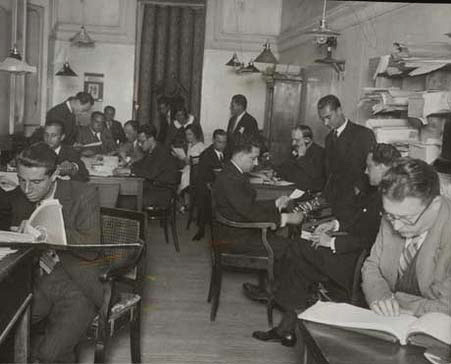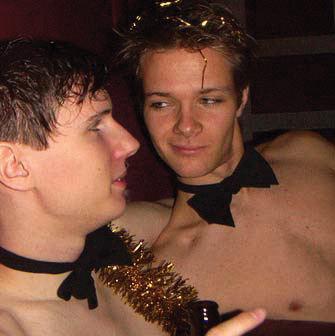
Source: Photo courtesy of Teresa Avellanosa, http://www.flickr.com/photos/49093093@N02/4649978754.
On Wall Street, S&T means sales and trades of stock, and it’s generally carried out by teams working for a bank or investment house. It’s their job to sniff out the best buys (and recommend them to their clients), while also picking up on which shares may be in for a fall so they can be unloaded fast.
On one of WallStreetOasis.com’s forum pages, welcome2nyc starts a thread this way: I was curious to know the culture of S&T. Can anyone give an honest opinion?welcome2nyc, March 20, 2010 (9:09 p.m.), “Culture on the Trading Floor…Changed?,” WallStreetOasis.com, accessed May 25, 2011, http://www.wallstreetoasis.com/forums/culture-on-the-trading-floorchanged.
A contributor named creditderivatives posts this about the culture at Deutsche Bank Equities: “These guys were brilliant and no-nonsense. Very tolerant atmosphere, but very focused. These guys argued over the correct pricing approach for equity swaps as opposed to which March Madness bound team had the best chance of winning it all.”
An “equity swap” is a complex financial bet, but in the end it comes down to this: one side believes a stock will go up (or down) more than another, and they put money on it.
BigFatPanda writes, “I’d rather work on a desk with the trash talk, like where people are on the verge of cutting each other.”
“A desk” is Wall Street talk for a team of analysts working together on investment strategies.
jjc1122 writes, “When i used to work at the chicago mercantile exchange, there were a lot of crazy stuff. traders routinely doing coke in the bathroom, old irish guys hurling racial insults, fights, and sleeping with their hot female clerks.”
He adds that his experience dates from 2005, but he’d heard that things were actually a lot crazier in the earlier part of the decade.
The instillation of a workplace culture through social conditioning functions in a variety of ways. Three are listed here. Can you fill in for each how it may have worked in the Chicago Mercantile Exchange in 2005?
Bondarb writes, “When i am out with goldman people and somebody tells a joke they all look at the most senior GS person there to see if they are allowed to laugh.” GS is Goldman Sachs, the global investment bank.

Source: Photo courtesy of Todd Baker, http://www.flickr.com/photos/technowannabe/1139227859.
Joel Manby is CEO of Herschend Family Entertainment, a $300 million corporation employing more than 10,000 people at two dozen theme parks around the country. They put on everything from massive aquariums to Dollywood, the Dolly Parton theme park in Tennessee.
In an interview, Manby discusses the corporate culture infusing the properties. It’s composed of eight attributes:
Manby exemplifies the corporate values he’s trying to instill this way, “You can dislike somebody, but you can still respect them, forgive them, and treat them with humility and honesty. We also have a phrase: ‘admonish in private, praise in public.’ So you don’t embarrass people.”
Manby explains that 50 percent of a Herschend executive’s year-end bonus is awarded on the basis of how well the organization’s culture is exhibited and promoted. As he puts it, “You have to put your money where your mouth is.”
He concludes with this: “It’s all about hiring the right people. You know, this culture either resonates with people or it doesn’t. If it doesn’t, they’re not going to enjoy working here.”Steve Tobak, Undercover Boss: Escaping GM’s Abusive Corporate Culture,” The Corner Office (blog), BNET, March 30, 2010, accessed May 25, 2011, http://blogs.bnet.com/ceo/?p=4254.
The characteristics of corporate culture elaborated in this chapter were the following. Corporate culture is
Choose three of these characteristics and show how the culture Manby promotes at Herschend Family Entertainment relates with each one.
Before coming to Herschend, Manby was CEO of Saab, a division of General Motors. His time there was marked by a very different organizational culture. According to him, “I don’t want to bash GM, but intimidation was part of the culture there. You would get ridiculed in meetings. The CEOs had big egos and had no problem making you look silly. I once missed one of my numbers. I didn’t miss it by that much, but the president of all of Saab calls me and orders me to fly over there [to Europe]. I get there Monday morning, he chews me out for four hours, and then I get on a plane and fly back. It was so humiliating, so uncalled for. I figured, if that’s the way I’m going to be treated, I don’t need that. That’s when I began looking at other opportunities.”Steve Tobak, Undercover Boss: Escaping GM’s Abusive Corporate Culture,” The Corner Office (blog), BNET, March 30, 2010, accessed May 25, 2011, http://blogs.bnet.com/ceo/?p=4254, brackets in the original.
Manby lists the attributes of the culture at Herschend—patience, kindness, honesty, and so on. What might a similar list look like for Saab?
Corporate culture provides an organization’s meaning; it defines what counts as success.
A corporate culture distinguishes workers from people who work. What is the distinction?
Manby says, “Apple’s culture, for example, would be very different from ours, but Steve Jobs is still an incredibly successful CEO. I’m not pretending we’re right and others are wrong; it’s just our culture, and it works for us.”
Explain how Manby can say that a set of ethical values isn’t right or wrong, but one set (at Saab) is wrong for him, and another set (at Herschend) is right for him?

Source: Photo courtesy of Sandra Cohen-Rose and Colin Rose, http://www.flickr.com/photos/73416633@N00/1363267249/.
The web store FinerBags.com sells fakes—very good copies of purses originally made by Louis Vuitton and similar high-end brands. The price is right: a $1,800 Prada bag can be purchased as a copy for about $180. At Finer Bags, they’re totally open about what they’re doing, and their home page lists the advantages of buying their products. According to the leadership at Finer Bags, “Millions of replica handbags can be found on internet these days, they are not a rare thing anymore. Maybe the Louis Vuitton handbag that your friend bought is a perfect replica. Maybe the Louis Vuitton Monogram Speedy 30 that Linda paid $1,200 for is a replica handbag. Maybe those replica bags all were bought from finerbags.com.”Business Ethics Workshop, accessed May 25, 2011, http://businessethicsworkshop.com/Chapter_9/finer_bags.html.
This company is selling counterfeit purses, bags designed to trick people into thinking they’re real when they’re not. No one denies that.
This line from the web page is curious: “Maybe the Louis Vuitton Monogram Speedy 30 that Linda paid $1,200 for is a replica handbag.” It’s important to know that the price of the real thing is about $1,200. The point being made is that people can end up paying full price for a copy. If that’s true, it sounds like Finer Bags is inviting people like you and me to realize that we can buy their fakes and then sell them as real, pocketing the difference.
Assume you’re running the fake purse outfit and hiring sales reps for other schools. You decide to reveal the truth about the purses’ origin to the reps. What you need to do next is instill a corporate culture that fosters lying. Common ways of instilling a workplace culture include the following:
How might these or other strategies of social conditioning be used to create a working culture that values lying?

Source: Photo courtesy of Carl Johan Crafoord, http://www.flickr.com/photos/carl-johan/53185001.
Not all leadership jobs are exercised from on top of a pyramid, with the president on the highest level, vice presidents below, then directors beneath them, and so on. Take the case of Carmen D’Alessio. “I created Studio 54!” she proclaims, even though she didn’t own any part of the club or have any official role in the way it was run. Still, according to her, if you want to find out about the once-thriving business, “I’m the most important person to talk to.”Jada Yuan, “As the Disco Ball Turns,” New York, April 30, 2007, accessed May 25, 2011, http://nymag.com/news/features/31277.
In the 1980s, Studio 54 was the New York City club. It began, according to D’Alessio, soon after she dined with two men—Ian Schrager and Steve Rubell—who owned a club in Queens, New York, an area not considered particularly trendy. She thought that Rubell possibly had some raw night-clubbing talent, so she encouraged him to bring his skills to hipper Manhattan.
To generate buzz before Studio 54 actually opened, she dressed Schrager and Rubell in Armani suits and threw a dinner in their honor attended by celebrated artist Andy Warhol, clothing designers Halston and Calvin Klein, and a host of similarly bright luminaries. Then, on the club’s first night, they went for an outlandish theme bash: 1001 Nights with elephants, camels, tents, men wearing turbans, belly dancers, and everything else packed onto the disco floor. Soon after the remarkable event, a widely distributed magazine at the time, Newsweek, put Studio 54 on their cover.
The parties D’Alessio threw were as outrageous and scandalous as the guests who turned up. One night Bianca Jagger (ex of Mick) rode in on a white horse; on another the designer Valentino got to act as the ringleader of real circus animals. Armani was feted with a drag-queen ballet. The bartenders were young, male, built, and shirtless. The busboys doubled as entertainers: dressed in tight little white shorts, bowties, and nothing else, they were given illicit drugs and a small paycheck and told to pick up glasses and party with the guests, who included fashion designers, artists, and unique people like Johannes von Thurn und Taxis, a flaming and wealthy European aristocrat whose wife was thirty years younger and so explosive that people called her Princess TNT. Malcolm Forbes, the hard-nosed American businessman, was a regular too. Everyone was welcome, as long as they were interesting.
In talking about it now, Carmen D’Alessio gives credit to the others, but never lets anyone forget what Andy Warhol said about Studio 54’s more visible leaders, Ian Schrager and Steve Rubell: “Carmen brought, hand in hand, Ian and Steve to the Big Apple.”
The line outside Studio 54 was infamous. People stretched around the block and waited hours to get in. Some waited all night and never reached the door. One reason things went so slowly for many is that D’Alessio enjoyed swooping out of the club, running down the line, and hand picking people to jump ahead and go straight in.
Studio 54 was a big-time vice den. Upstairs in the shadowy balcony people regularly coupled. Drugs were as common as beer. (A large glittery moon with a face and arms hung from the ceiling. It was snorting cocaine.) Management knew about all this and encouraged it.
Though not a lot of clothing was worn by frontline employees, this doesn’t change the fact that there was a very strict dress code at Studio 54.
Carmen D’Alessio was behind the scenes at Studio 54, throwing the parties, arranging people, setting the tone of the place. With respect to Daniel Goleman’s six basic leadership personas listed below, which ones do you suspect correspond with D’Alessio, and which don’t fit her so well? Why?
Part of the reason for naming a leadership style a leadership persona is to underline the idea that being a leader can be like donning a mask: you can be whatever you choose when you stand in front of others and direct. Besides being a leader at Studio 54, D’Alessio was also a massive partier. How is adopting a personality for leading an organization like adopting a style to exhibit when you go out with friends on the weekend?